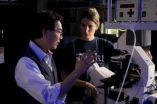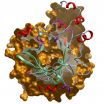Researchers confirm prenatal heart defects in spinal muscular atrophy cases
University of Missouri professor says new concept could lead to better therapies and supportive care
2010-09-29
(Press-News.org) COLUMBIA, Mo. – University of Missouri researchers believe they have found a critical piece of the puzzle for the treatment of Spinal Muscular Atrophy (SMA) – the leading genetic cause of infantile death in the world. Nearly one in 6,000 births has SMA, and it is estimated that nearly one in 30 to 40 people have the trait that leads to SMA.
In a new study in Human Molecular Genetics, Christian Lorson, professor in the Department of Veterinary Pathobiology and the Department of Molecular Microbiology and Immunology, has found prenatal cardiac defects in mice with SMA. Lorson believes this discovery has implications for eventual treatment as clinicians can no longer concentrate exclusively on the nervous system when treating SMA.
Lorson's research team, headed by Monir Shababi, research scientist, examined two animal models of SMA and discovered that cardiac defects are found throughout SMA development and include neonatal fibrosis in the heart, ventricle malformation, thinning of the cardiac wall and slower heart rates.
"It is likely that in severe cases of SMA, the disease is not limited to motor neurons; rather, it becomes a multisystem disease, and the cardiac contribution is just one of the systems," said Lorson, who works in the MU Bond Life Sciences Center. "These results are consistent with clinical reports of severe SMA cases that describe a number of cardiac defects. To fully address this disease, any new therapies or drugs must be effective in every tissue, not just motor neurons. The more we understand the disease, the better off we will be in terms of developing therapeutics or better supportive care. What this conservatively means for humans is that therapies have to go beyond the nervous system in the most severe and most profound cases."
Spinal muscular atrophy is caused by loss of a gene known as SMN1. Humans have an additional gene called SMN2 which only makes a small amount of the normal SMN protein – the protein required to prevent SMA. SMN1 and SMN2 are greater than 99 percent identical, but a small difference between the two causes the dramatic difference in the amount of functional protein produced by SMN2.
Typically, the disease moves from the outlying limbs into the trunk of the body. Most deaths are caused by respiratory failure in the lungs. Researchers have been targeting SMN2 – what Lorson calls the "partially functioning backup copy" – because any increase in SMN2 means better results.
"SMN2 is like a light that's been dimmed, and we're trying anything to get it brighter. Even turning it up a little bit would likely help dramatically," Lorson said.
INFORMATION:
END
ELSE PRESS RELEASES FROM THIS DATE:
2010-09-29
Montreal September 28, 2010 – Multicultural education in classrooms has failed to produce a deeper understanding across cultures, according to a Concordia University researcher. Education professor Adeela Arshad-Ayaz blames teacher training for failing to address issues of diversity and equity. Her recent presentation at the Congress of the Humanities and Social Sciences, in Montreal, calls for an alternative approach.
"The way we currently teach multiculturalism fails to bring divergent groups together," says Dr. Arshad-Ayaz. "Our present approach is alienating minority ...
2010-09-29
CINCINNATI—Firefighters are exposed to potentially dangerous levels of ultrafine particulates at the time they are least likely to wear protective breathing equipment. Because of this, researchers believe firefighters may face an increased risk for heart disease from exposures during the fire suppression process.
Coronary heart disease is the No. 1 killer of American firefighters, with many of these incidents taking place during or just after a firefighting incident. Researchers say exposure to these harmful ultrafine air particulates could predispose firefighters to ...
2010-09-29
PHILADELPHIA (September 28, 2010) – Scientists at the Monell Center have used a well-known example of individual differences to identify a genetic contribution to the sense of smell.
Most people detect a distinct sulfurous odor in their urine shortly after eating asparagus. However, there are some who seemingly do not notice the unpleasant odor.
Up until now, it has been unclear whether this is because these individuals do not produce the odor or because they cannot smell it.
Addressing this mystery from several angles, scientists from the Monell Center first used ...
2010-09-29
HIV-infected individuals who begin antiretroviral therapy (ART) soon after acquiring the virus may have stronger immune responses to other pathogens than HIV-infected individuals who begin ART later, a new study from the National Institutes of Health has found. This finding suggests that early initiation of ART may prevent irreversible immune system damage and adds to the body of evidence showing significant health benefits from early ART.
Scientists from the National Institute of Allergy and Infectious Diseases, part of NIH, measured the quantity and qualities of B cells ...
2010-09-29
Dairy farmers can greatly reduce ammonia emissions from their production facilities by injecting liquid manure into crop fields below the soil surface, according to research by the U.S. Department of Agriculture (USDA).
These findings, which resulted from a study conducted by soil scientist April Leytem and agricultural engineer David Bjorneberg with USDA's Agricultural Research Service (ARS), could help Idaho dairy farmers increase nitrogen capture in the soil and protect air quality from agricultural ammonia emissions. ARS is USDA's principal intramural scientific ...
2010-09-29
DURHAM, N.C. – Duke University bioengineers have not only figured out a way to sneak molecular spies through the walls of individual cells, they can now slip them into the command center -- or nucleus -- of those cells, where they can report back important information or drop off payloads.
Using silver nanoparticles cloaked in a protein from the HIV virus that has an uncanny ability to penetrate human cells, the scientists have demonstrated that they can enter the inner workings of the nucleus and detect subtle light signals from the "spy."
In order for these nano-spies ...
2010-09-29
A study conducted at Copenhagen University Hospital showed that treatment of rheumatoid arthritis (RA) with disease modifying antirheumatic drugs (DMARDs), glucocorticoids, biologic agents, or a combination of agents significantly reduced radiographic evidence of joint destruction, with a relative effect of 48%% as compared with placebo. A direct comparison between the combination of a biologic agent plus methotrexate and the combination of 2 DMARDs plus initial glucocorticoids revealed no difference. Study findings are published in the October issue of Arthritis ...
2010-09-29
Social rejection isn't just emotionally upsetting; it also upsets your heart. A new study finds that being rejected by another person makes your heart rate drop for a moment. The study is published in Psychological Science, a journal of the Association for Psychological Science.
Research has shown that the brain processes physical and social pain in some of the same regions. Bregtje Gunther Moor, Eveline A. Crone, and Maurits W. van der Molen of the University of Amsterdam and Leiden University in the Netherlands wanted to find out how social pain affects you physically. ...
2010-09-29
Results from a 12-month multi-center clinical trial did not show therapeutic benefit of abatacept over placebo in patients with non-life threatening systemic lupus erythematosus (SLE). Abatacept failed to prevent new disease flares in SLE patients tapered from corticosteroids in an analysis where mild, moderate and severe disease flares were evaluated together. Full details of the phase IIb clinical trial are published in the October issue of Arthritis & Rheumatism, a journal of the American College of Rheumatology (ACR).
The ACR estimates that 161,000 to 322,000 adults ...
2010-09-29
The Structural Genomics Consortium (SGC), an international public-private partnership that aims to determine three dimensional structures of medically important proteins, announced today the release into the public domain of its 1000th high resolution protein structure.
The 1000th structure – known as JmjD2C – belongs to a class of proteins involved in epigenetic signalling, a key research area for the SGC. Epigenetics is the study of inherited changes in gene expression caused by proteins such as JmjD2C which 'switch' genes on or off. It is believed that a better understanding ...
LAST 30 PRESS RELEASES:
[Press-News.org] Researchers confirm prenatal heart defects in spinal muscular atrophy cases
University of Missouri professor says new concept could lead to better therapies and supportive care

